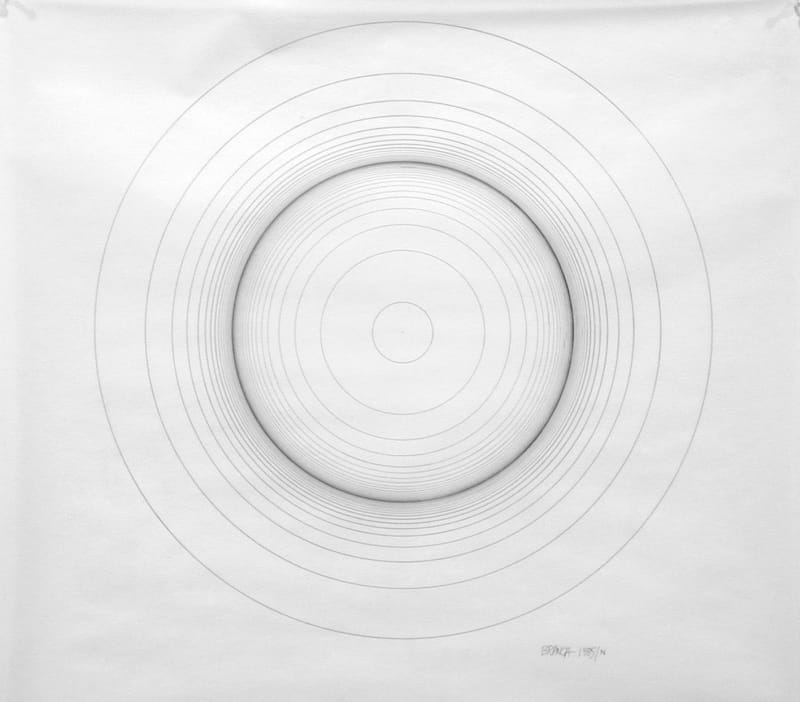Marianne Boesky Gallery is pleased to present a group exhibition of video, drawing, photography, and painting, Half Air. The works are presented as a concatenation of themes of architecture, geometry, religion, ritual, color, and motion. The artists are themselves as multidisciplinary as the exhibition. Included are long-unseen drawings by composer Glenn Branca, which visually represent the harmonic series in finely-rendered geometrical patterns; pioneering 70’s video work and a wall installation by composer/performer/artist Charlemagne Palestine, documenting his body art phase; “By the Sea,” a film by The Wooster Group and longtime collaborator Ken Kobland, (featuring several of the Group’s core performers) originally presented in their 1980 production Point Judith (an epilog); an installation of arrangeable photo cubes along with the “16 Immortal Photographs” by the legendary NY underground filmmaker and performance artist Jack Smith; and works on paper by James Bishop which enact a subtle geometry of hovering painted forms. Branca has noted that when creating his drawings he began “to see the kind of transformations that can occur, in the same way a musical composition can modulate into a different key or transform subtly into a different structure.” This statement finds resonance in the painter Forrest Bess’ themes of private transformative symbols and energy through forms and arrangements. Transformation is implied in all these works, as sound becomes image, shape becomes motion, and nature is reduced to form.
The works in the show almost seem to be interacting with each other. The muted colors of Smith’s photos are echoed in Bishop’s drained color scheme and Palestine’s bubblegum pink wall. Palestine’s performances represent a physical communion with the sacred; “By the Sea” features several actors dressed as nuns performing daily rituals. The house the nuns inhabit is reminiscent of the structures in Bishop’s paintings; the rocks on the shore in “By the Sea” also turn up in Bess’ paintings, intersecting a circle, bringing to mind the ancient Druid edifices of Stonehenge (arranged in a circle, serving a mystical purpose). This mysticism is fitting to be evoked by a theatre piece, as the architecture of European theatres in centuries past was often modeled on the circle of the zodiac, with the orchestra as the center of the circle and the twelve entrances to both the stage and the auditorium representing the astrological signs. Shakespeare’s own Globe Theatre was a circle in a square, as are many of the works here: in his videos, Palestine runs in circles around a four-walled gallery space chanting; in “By the Sea” the camera repeats a slow circular pan around a sea landscape; Branca, a former playwright, draws infinitely expanding circles on square sheets of paper.
In his book Art and Symbols of the Occult, James Wasserman writes, in a caption to an illustration of Leonardo Da Vinci’s “The Proportions of the Human Figure According to Vitruvius”, that “the geometry of the human body is indicative of the highest mysteries of the cosmos. The circle may be formed from a person lying on his back, with a compass placed at the navel. The square is formed from the measure of the height from head to toe, and with the width of the outstretched arms. Man is a microcosm, the perfect image of the universe.” Man has amplified its own intrinsic microcosmic dimension by using the body in circular motion to achieve transcendence. As artist Dan Graham has written, Puritan concentric circle dancing and Native American Ghost Dances involved circular movement towards a spiritual end. These were eventually transformed into tent revival meetings and later, the rock concert theatrics of both performers and audience—people reeling and rocking to be cleansed, and ultimately reborn. The true aim of the transformations in all of the works in “Half Air” is a kind of rebirth, both for the works’ creators and their viewers.
—Alan Licht
musician/writer, NYC

